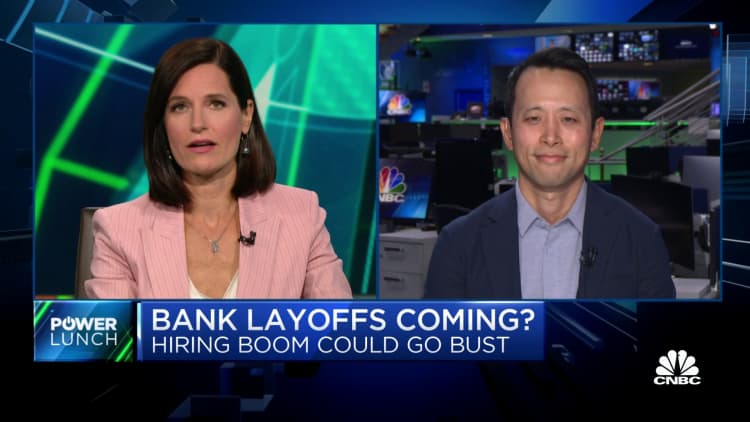Pedestrians walk along Wall Street near the New York Stock Exchange in New York.
Michael Nagle | Bloomberg | Getty Images
The largest American banks have been quietly laying off workers all year — and some of the deepest cuts are yet to come.
Even as the economy has surprised forecasters with its resilience, lenders have cut headcount or announced plans to do so, with the key exception being JPMorgan Chase, the biggest and most profitable U.S. bank.
Pressured by the impact of higher interest rates on the mortgage business, Wall Street deal-making and funding costs, the next five largest U.S. banks cut a combined 20,000 positions so far this year, according to company filings.
The moves come after a two-year hiring boom during the pandemic, fueled by a surge in Wall Street activity. That subsided after the Federal Reserve began raising interest rates last year to cool an overheated economy, and banks found themselves suddenly overstaffed for an environment in which fewer consumers sought out mortgages and fewer corporations issued debt or bought competitors.
“Banks are cutting costs where they can because things are really uncertain next year,” Chris Marinac, research director at Janney Montgomery Scott, said in a phone interview.
Job losses in the financial industry could pressure the broader U.S. labor market in 2024. Faced with rising defaults on corporate and consumer loans, lenders are poised to make deeper cuts next year, said Marinac.
“They need to find levers to keep earnings from falling further and to free up money for provisions as more loans go bad,” he said. “By the time we roll into January, you’ll hear a lot of companies talking about this.”
Deepest cuts
Banks disclose total headcount numbers every quarter. While the aggregate figures mask the hiring and firing going on beneath the surface, they are informative.
The deepest cuts have been at Wells Fargo and Goldman Sachs, institutions that are wrestling with revenue declines in key businesses. They each have cut roughly 5% of their workforce so far this year.
At Wells Fargo, job cuts came after the bank announced a strategic shift away from the mortgage business in January. And even though the bank cut 50,000 employees in the past three years as part of CEO Charlie Scharf‘s cost-cutting plan, the firm isn’t done shrinking headcount, executives said Friday.
There are “very few parts of the company” that will be spared from cuts, said CFO Mike Santomassimo.
“We still have additional opportunities to reduce head count,” he told analysts. “Attrition has remained low, which will likely result in additional severance expense for actions in 2024.”
Goldman firings
Meanwhile, after several rounds of cuts in the past year, Goldman executives said that they had “right-sized” the bank and don’t expect another mass layoff like the one enacted in January.
But headcount is still headed down at the New York-based bank. Last year, Goldman brought back annual performance reviews where people deemed low performers are cut. In the coming weeks, the bank will terminate around 1% or 2% of its employees, according to a person with knowledge of the plans.
Headcount will also drift lower because of Goldman’s pivot away from consumer finance; the firm agreed to sell two businesses in deals that will close in coming months, a wealth management unit and fintech lender GreenSky.
A key factor driving the cuts is that job-hopping in finance slowed drastically from earlier years, leaving banks with more people than they expected.
“Attrition has been remarkably low, and that’s something that we’ve just got to work through,” Morgan Stanley CEO James Gorman said Wednesday. The bank has cut about 2% of its workforce this year amid a protracted slowdown in investment banking activity.
The aggregate figures obscure the hiring that banks are still doing. While headcount at Bank of America dipped 1.9% this year, the firm has hired 12,000 people so far, indicating that an even greater amount of people left their jobs.
Citigroup’s cuts
While Citigroup‘s staff figures have been stable at 240,000 this year, there are significant changes afoot, CFO Mark Mason told analysts last week. The bank has already identified 7,000 job cuts linked to $600 million in “repositioning charges” disclosed so far this year.
CEO Jane Fraser’s latest plan to overhaul the bank’s corporate structure, as well as sales of overseas retail operations, will further lower headcount in coming quarters, executives said.
“As we continue to progress in those divestitures … we’ll see those heads come down,” Mason said.
Meanwhile, JPMorgan has been the industry’s outlier. The bank grew headcount by 5.1% this year as it expanded its branch network, invested aggressively in technology and acquired the failed regional lender First Republic, which added about 5,000 positions.
Even after its hiring spree, JPMorgan has more than 10,000 open positions, the company said.
But the bank appears to be the exception to the rule. Led by CEO Jamie Dimon since 2006, JPMorgan has best navigated the surging interest rate environment of the past year, managing to attract deposits and grow revenue while smaller rivals struggled. It’s the only one of the Big Six lenders whose shares have meaningfully climbed this year.
“All these companies expanded year after year,” said Marinac. “You can easily see several more quarters where they go backwards, because there’s room to cut, and they have to find a way to survive.”




